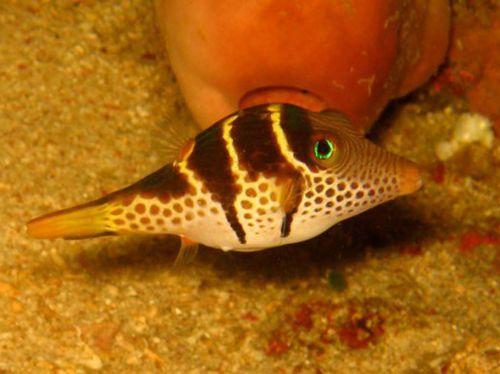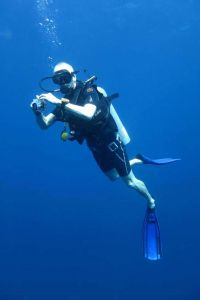 Koh Phi Phi has a bit of everything, except motorized transport. The island is a hugely-popular tourist destination for visitors from all over the world. Some just come on a day trip, but most come for a few days and end up staying longer than they expected. There are actually two main islands, but only the larger (Koh Phi Phi Don) has any accommodation, shops or restaurants. The smaller of the two (Koh Phi Phi Lei) is where the movie The Beach was made in 1998 & 1999. During the high season Maya Bay (Phi Phi Lei) soon becomes packed with tourists and the boats they arrive on.
Koh Phi Phi has a bit of everything, except motorized transport. The island is a hugely-popular tourist destination for visitors from all over the world. Some just come on a day trip, but most come for a few days and end up staying longer than they expected. There are actually two main islands, but only the larger (Koh Phi Phi Don) has any accommodation, shops or restaurants. The smaller of the two (Koh Phi Phi Lei) is where the movie The Beach was made in 1998 & 1999. During the high season Maya Bay (Phi Phi Lei) soon becomes packed with tourists and the boats they arrive on.
A large number of tourists come to Koh Phi Phi to scuba dive. There are as many as ten great diving spots around the islands, most of the best being nearer to Koh Phi Phi Lei. The diving is extremely good here for a number of reasons. The most important is probably that the diving is consistently good for much of the year. Although the official low season is June-September, it is actually still ok to dive at those times. The period is known as the low season due to the monsoon winds causing waves to be an issue, but there is nearly always a sheltered dive site at Koh Phi Phi, whatever the weather.
 Diving at Koh Phi Phi is ideal for all levels of diver. Those who have never dived before can enjoy a Discover Scuba Diving introductory dive, or even take part in a PADI or SSI diving course and learn to become a certified scuba diver. Already-certified divers can enjoy a wide range of diving conditions and marine life here at Koh Phi Phi. There’s always the opportunity to find a spot of deep water or a shallow reef, as well as a current or calm spot, depending on each diver’s preference. Visibility is generally 10-20+ metres most of the year. The marine life at Koh Phi Phi diving sites is also very good. Lots of reef fish of all shapes, colours and sizes live here and there are several pelagic species which pay a visit, too. These sometimes include Manta Rays (Manta alfredi) and Whale Sharks (Rhincodon typus), but not nearly as often as at Hin Daeng or the Similan Islands. Leopard/Zebra Sharks (Stegostoma fasciatum) are real sharks, but placid, nocturnal bottom dwellers and no threat at all to humans. In fact, after a diver’s first few sightings, these soon become of little interest. Predatory Blacktip Reef Sharks (Carcharhinus melanopterus) are much more shy, and can sometimes be spotted in the shallows, but soon disappear. In fact, these sharks are easier to spot when snorkelling at Phi Phi than when diving. Reptiles, such as Green and Hawksbill Turtles are regularly spotted on a dive at Phi Phi, and Banded Sea Kraits (snakes) are relatively common, too.
Diving at Koh Phi Phi is ideal for all levels of diver. Those who have never dived before can enjoy a Discover Scuba Diving introductory dive, or even take part in a PADI or SSI diving course and learn to become a certified scuba diver. Already-certified divers can enjoy a wide range of diving conditions and marine life here at Koh Phi Phi. There’s always the opportunity to find a spot of deep water or a shallow reef, as well as a current or calm spot, depending on each diver’s preference. Visibility is generally 10-20+ metres most of the year. The marine life at Koh Phi Phi diving sites is also very good. Lots of reef fish of all shapes, colours and sizes live here and there are several pelagic species which pay a visit, too. These sometimes include Manta Rays (Manta alfredi) and Whale Sharks (Rhincodon typus), but not nearly as often as at Hin Daeng or the Similan Islands. Leopard/Zebra Sharks (Stegostoma fasciatum) are real sharks, but placid, nocturnal bottom dwellers and no threat at all to humans. In fact, after a diver’s first few sightings, these soon become of little interest. Predatory Blacktip Reef Sharks (Carcharhinus melanopterus) are much more shy, and can sometimes be spotted in the shallows, but soon disappear. In fact, these sharks are easier to spot when snorkelling at Phi Phi than when diving. Reptiles, such as Green and Hawksbill Turtles are regularly spotted on a dive at Phi Phi, and Banded Sea Kraits (snakes) are relatively common, too.
The diving conditions around Koh Phi Phi are consistent, with the choice of 30m. deep dives and lots of life around shallow reefs. The most popular dive spots at Koh Phi Phi are Koh Bida Nai and Koh Bida Nok. These are the two rocky outcrops / islets at the southern tip of Koh Phi Phi Lei. Inside Maya Bay and around the back of Phi Phi Lei there are more nice diving spots, and out in the bay of Phi Phi Don there are one or two, as well. In May 2014 a large navy ship was deliberately sunk there, making an exciting new wreck dive site for Advanced divers or those taking part in the Advanced Open Water Course.
Diving boats visit Koh Phi Phi dive sites from all around. Phi Phi Don has well over a dozen PADI dive centers who come here on day trips. In addition, day trip boats come here from neighbouring Koh Lanta and Phuket, as well as a selection of liveaboard diving boats, on a 2D/1N or 3D/2N diving safari.


